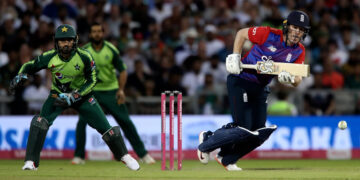
This Test is not yet lost, but England can certainly reflect on a lost weekend in which their bowlers have been rendered helpless by Hashim Amla’s monolithic triple century and their batsmen hapless by an attack confident the wounds they have inflicted on the top dog are more than superficial.
It has so far been a mauling for the world’s No I Test team, especially the bowlers, who have the return of just one wicket in their last 186.2 overs, which is just over two days of playing time.But just as they might have been lining up the benign nature of the pitch as mitigation, and to add insult to injury, up pops Dale Steyn and Co to knock the stuffing out of the batsmen in England’s second innings to embarrass them further.
England have a recent history of repelling South Africa’s marauding bowlers when all looks lost and they will need to call on those resources again in order to draw the match. At the moment they are 102-4, with Ian Bell and Ravi Bopara at the crease, but you sense their innings must go into the final session of play on Monday for them to be enough runs ahead of South Africa for the Test to be safe.
It was probably those successful rearguards, both on the last tour of South Africa, that persuaded Graeme Smith to declare 252 ahead when most thought he might put at least 300 between his team and England before unleashing his bowlers. But if he had doubts over his timing they were swiftly dashed when Vernon Philander had Alastair Cook caught behind for a duck in the second over of the innings.It was the perfect start and the straitjacket it created meant it was only a matter of time before another wicket followed. Pressure is a remorseless force and Jonathan Trott, usually one of England’s best at repelling it, succumbed, hanging his bat out lamely to a ball from Steyn that he would have left alone in less fraught circumstances.
If that was telling of human nature so too was Kevin Pietersen’s dismissal, clean bowled by Morne Morkel for 16. Charging in from the Pavilion End, Morkel roughed Pietersen up with a series of bouncers.His aggression obvious, Pietersen wilted and he should have been out fending a short ball to second slip except Jacques Kallis, who’d earlier made a superb unbeaten 189 with the bat, floored the catch. Pietersen did not remain at liberty for long and when he played the curtain rail to Morkel soon after to lose his off-stump, it appeared that the fast bowler had eroded his confidence in just three hostile overs.
It was a prequel that did for Andrew Strauss too, though the softening process for him was a throat ball from Imran Tahir that bounced alarmingly out of the footholes. That snorter made Strauss, who’d looked secure until then, suddenly opt for more scoring options against the leg-spinner of which the sweep was probably the least safe, something proved by the top edge that dollied up to Philander.
The travails of England’s batsmen had not been experienced by Amla, whose unbeaten 311 was the first triple hundred in England for 22 years. Amla’s calm is legendary but he needed more than that, calling upon reserves of concentration not available to most mortals. Even if the bowling had been underarm, which it wasn’t, to withstand it for 13 hours and nine minutes and score over 300 runs off it is phenomenal.The worrying thing for England is that his score didn’t really look in doubt once he’d reached his first hundred. Two sharp chances, one to Strauss on 40 on Friday (yes it was that long ago) and the other Ravi Bopara on 305, were the only mistakes he made.
Other than them it was a remorseless display of batting in which he appeared to have time to change his mind before every stroke, a luxury against England’s attack that hasn’t occurred since the Brisbane Test against Australia 18 months ago.His unbroken 377-run partnership with Kallis ground England’s bowlers into submission. No team before then has ever compiled two successive partnerships of over 200 against them. Judging from the home side’s harrowing body language it was not a contingency they’d really prepared for. Even a No 1 team can have an off day but the figures blighting England were catastrophic.
Instead of home, the pitch behaved like some corner of a field that was very foreign. If there were any positives for England’s bowlers it was that it has given them a foretaste of India this autumn.Kallis, whose batting record in England has not been good, took advantage of the conditions. A batsman who can be as one-paced as he is classical, he simply eased his way to an unbeaten 182, his 43rd Test hundred.His value to South Africa is not from runs alone and his fine bowling will no doubt be called upon on Sunday. Indeed, only two players in Test history average more than 40 with the bat but fewer than 33 with the ball over more than 20 Tests. One is Kallis, the other Tony Greig.
England’s best hope, given the lack of swing or seam movement, lay with Graeme Swann. There had been slow turn since the second day, but Swann, who seems to get despondent when faced with right-handers prepared to get across their crease to nullify the lbw, barely threatened them. With the pitch slow, he needed to bowl a bit quicker but, hindered by a sore elbow, seemed unable to do so.
Stuart Broad also seemed under par, his speeds with the third new ball around the 80mph mark when he usually operates between 86-88mph.Part of England’s problem, and it must be stressed that this hasn’t cropped up often over the past few years, is that the current pace attack comprises precision instruments who operate to a tight plan and who need the ball to move.When neither is working you need a battering ram and there’s only one of those in this match, and its name is Morkel. – Telegraph












